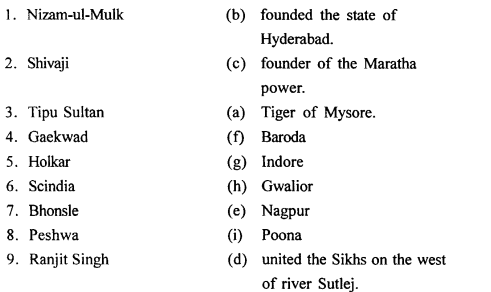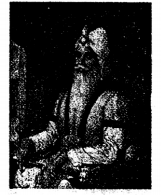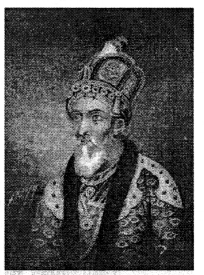ICSE Solutions for Class 8 History and Civics – India in the Eighteenth Century
ICSE SolutionsSelina ICSE SolutionsML Aggarwal Solutions
APlusTopper.com provides step by step solutions for ICSE Solutions for Class 8 History and Civics. You can download the History and Civics ICSE Solutions for Class 8 with Free PDF download option. History and Civics for Class 8 ICSE Solutions all questions are solved and explained by expert teachers as per ICSE board guidelines.
ICSE Solutions Class 8 History & Civics GeographyBiologyChemistryPhysicsMaths
Time To Learn
I. Fill in the blanks:
- Murshid Quli Khan became the independent ruler of Bengal and shifted his capital to Murshidabad.
- Chin Qilich Khan founded the Asaf Jahi dynasty in AD 1724.
- Haider Ali was the ruler of Mysore.
- Banda Bahadur was the leader of the Sikhs after the death of Guru Govind Singh.
- Balaji Vishwanath was the first Peshwa.
II. Match the contents of Column A and Column B:


Answer:

III. State whether the following statements are True or False:
- The office of the Peshwas was always hereditary.
False. - In the Third Battle of Panipat, the Marathas fought with the Rajputs and the Jats.
False. - The later Mughal kings were able rulers.
False. - Safdar Jung was the first Nizam of Hyderabad.
False. - Jai Singh built an observatory (Jantar Mantar) and Pink City (Jaipur).
True.
IV. Answer the following questions:
Question 1.
Write in brief the causes that led to the downfall of the Mughal empire.
Answer:
Causes that led to the downfall of Mughal Empire were
(a)
Weak successors: After Aurangzeb’s death the Mugh empire started declining. His successors were weak are were toys in the hands of nobles and Governors. The lacked the administrative skills of their predecessors.
(b)
Internal Rivalry: The nobles and Governors belonged different groups and were always engaged in const? struggle for power. This hampered the growth of the emp
(c)
Crisis in Jagirdari and Mansabdari system: The Mugh introduced the Jagirdari and the mansabdari systems , smooth running of their administration but they only prov to be the cause of the decline of their empire.
(d)
Invasion of Nadir Shah and Ahmad Shah Abdali: Duri the reign of Mohammad Shah two foreign invasions crippl the Mughal empire. They invaded India and weakened tl Mughal Empire.
Question 2.
When and between whom was the Third Battle of Panipa fought? What were its results?
Answer:
The third battle of Panipat was fought in 1761 between Ahmad Shah Abdali, an Afghan invader and Peshwa Balaji Baji Rao. The Peshwa suffered a crushing defeat and this put an end to the Maratha power.
Question 3.
Name the first independent Nawab of Bengal. What were his achievements?
Answer:
Murshid Quli Khan became the first independent Nawab of Bengal. He established an efficient administration and effectively organised the revenue system. He also started the new system of land revenue collection, on the basis of contracts, known as Ijara system. He reorganised the zamindari for which he is will remembered in the history of Bengal.
Question 4.
When was the Battle of Plassey fought? What effect did it have on the position of the English East India Company?
Answer:
The Battle of Plassey was fought in 1757 between the British and Siraj-ud-daulah in which the English defeated the army of Siraj-ud-daulah. From then onwards the English East India Company functioned as king makers in Bengal politics. Finally,the English established their full sway in 1765 when Robert Clive set up the Dual Government in Bengal.
Question 5.
Who was Haider All? Discuss his achievements.
Answer:
Hyder All was the ruler of Mysore. He started his career as an ordinary soldier in the Mysore army. He won many battles against the Marathas, the Nizam of Hyderabad and routed his enemies in two consecutive Anglo-Mysore Wars.
Question 6.
Which ruler was known as the Tiger of Mysore?
Answer:
Tipu Sultan, the son and heir of Haider Ah and ruler of Mysore is known as ‘Tiger of Mysore.
V. Tell me why
Question 1.
The consequence of the Third Battle of Panipat was n advantageous for the British.
Answer:
The Marathas had established a Maratha Kingdom during the reign of Aurangzeb. They were very powerful and with time and with the decline of the Mughals would have proved worthy , opponents to the emerging British empire but the third Battle of Panipat (1761) sealed their fate. Ahmad Shah Abdali, an Afghan . invader gave a crushing defeat to the forces of Peshwa Balaji Baji Rao. It put an end to the Maratha power and their dream of ruling India. Thus, the way was proved for the British East India Company to gain power and become supreme.
Question 2.
Independent states were formed in the 18th century.
Answer:
The later Mughal rulers were so weak that they could not hold the provinces of the empire together. These provinces were under Governors who were always engaged in wars. Gradually, they took advantage of the situation of misrule and misgovemance by the central authority and declared independence.Thus, Bengal, Hyderabad, Awadh Rohikhand became independent one after the other.
VI. Pictury study – This is a picture of a great ruler of Punjab.

Question 1.
Identify him.
Answer:
Maharaja Ranjit Singh.
Question 2.
How did the unite the Sikhs in Punjab?
Answer:
Maharaja Ranjit Singh brought the whole area west of River Sutlej under his control and established the Sikh kingdom in Punjab. He signed the Treaty of Amritsar (1809) with the British which confirmed his conquests and established his sovereignty over the terrioty west of Satluj. It was only after his death in 1839 that the British gained control over the Punjab.
Additional Questions
EXERCISES
A. Fill in the blanks:
- During the first half of the 18th century, the great Mughal empire decayed and disintegrated.
The Mughal emperors who ruled India after the death of Aurangzeb are known as the later Mughals. - There were four groups of nobles in the Mughal court.
- Nadir Shah looted and plundered Delhi He carried away immense treasures including the priceless Kohinoor and the Peacock Throne.
- Ahmad Shah Abdali, the ruler of Afghanistan, repeatedly attacked the Mughal empire.
- Bahadur Shah Zafar, was defeated in the Revolt of 1857 and exiled to Rangoon by the British.
B. Match the following:

![]()
Answer:

C. Choose the correct answer:
- Aurangzeb/Akbar/Shah Jahan followed a policy of religious intolerance.
Ans. Aurangzeb followed a policy of religious intolerance. - The military campaign in the Deccan led by Shah Jahan/ Aurangzeb/Akbar ruined the Mughal empire financially
Ans. The military campaign in the Deccan led by Aurangzeb ruined the Mughal empire financially. - The invasions of Ahmad Shah Abdali, the ruler of Afghanistan/Persia/Iraq shattered the power and prestige of the Mughal empire.
Ans. The invasions of Ahmad Shah Abdali, the ruler of Afghanistan shattered the power and prestige of the Mughal empire. - The Mughal empire lasted for over 3/5/6
Ans. The Mughal empire lasted for over 3 centuries. - The British ruled over India for a 100 years/nearly 200 years/ 300 years.
Ans. The British ruled over India for nearly 200 years.
D. State whether the following are true or false.
- Bahadur Shah ascended the throne after the death of Aurangzeb.
True. - The Mughal court was united and stable.
False
Correct:- The Mughal court was divided and unstable. - The Mughal officers were given jagirs as payments for their services.
True. - The Mughal rulers did not have a navy.
True. - The successors of Aurangzeb were very strong and efficient.
False.
Correct: The successors of Aurangzeb were very weak and unefficient.
E. Answer the following questions in one or two words/ sentences:
Question 1.
When did the transition from the Medieval to the Modern Period begin in India?
Answer:
The transition from the Medieval to the Modem Priod began with the decline of the Mughal empire in the first half of the 18th century.
Question 2.
Name the first and the last emperors in the line of the Later Mughals.
Answer:
Bahadur Shah first in the line of emperors referred to as the Later Mughals. Bahadur Shah Zafar last emperor in the line of the Later Mughals.
Question 3.
Name any two rival groups of nobles in the Mughal court.
Answer:
- The Iranis hailed from Persia
- Turanis hailed fromTransoxiana.
Question 4.
Mention any two reasons for the failure of the mansabdari system.
Answer:
Mansabdars had to maintain a fixed number of troops. They were given jagirs as the payment for doing so. Later, an increase in the number of mansabs and a shortage of jagirs led to corruption and inefficiency in the system.
Question 5.
What was the economic impact of the Mughal wars of succession?
Answer:
After the death of a Mughal ruler, generally there were wars of succession among rival claimants to the throne. These wars proved very costly and destructive. They drained the resources of the empire and made it instable and weak.
Question 6.
How did Aurangzeb’s religious policy affect the relationship between the Mughals and the Rajputs?
Answer:
Aurangzeb’s policy of religious intolerance shook the foundations of the empire and resulted in the following:
- The costly, long-drawn and ruinous Deccan campaign.
- Numerous wars with the Sikhs, the Marathas, the Jats and the Rajputs.
- Loss of support of the loyal Rajputs who had earlier contributed greatly to the stability of the Mughal empire but now became its bitter foes.
Question 7.
What led to the drain on the royal treasury during Shah Jahan’s reign?
Answer:
The enormous sums of money spent by Shah Jahan on magnificent monuments like the Taj Mahal had drained the royal treasury.
Question 8.
Which Mughal emperor assumed leadership of the Revolt of 1857? What happened to him after the Revolt?
Answer:
Bahadur Shah Zafar, the last of the Mughals, assumed leadership of the rebels in the Revolt of 1857 against the British. He was defeated and exiled to Rangoon where he died. The Mughal empire came to an inglorious end.
F. Answer the following questions briefly.
Question 1.
Several factors were responsible for the decline of the Mughal empire. In this context answer the following questions:
(a).How did court politics undermine the authority and prestige of the Mughal empire?
(b).To what extent was the jagirdari crisis responsible for a further decline of the power of the emperor?(c).How did the wars of succession destabilize the Mughal empire?
Answer:
(a).
There were four groups of nobles in the Mughal court- Iranis, Turanis, Afghans and Hindustanis. The Iranis hailed from Persia, the Turanis hailed from Transoxiana, and the Afghans came from the mountainous border regions across the river Indus. The Mughal court was a house sharply divided from within. This resulted in a constant struggle for power among these groups. Their mutual jealousies and rivalries caused great harm to the Mughal administration and undermined the prestige and authority of the Mughal emperor.
(b)
The Mughal officers were given jagirs as payment for their services. Towards the end of the 17th century, there were very few jagirs left. To satisfy the demands of the newly recruited officers, crown lands were converted to jagir lands and given to the nobles. This led to a loss of revenue for the royal treasury and a further decline in the power of the emperor.
(c)
After the death of a Mughal ruler, generally there were wars of succession among rival claimants to the throne. These wars proved very costly and destructive. They drained the resources of the empire and made it instable and weak.
Question 2.
With reference to the decline and disintegration of
(a) The Mughal empire discuss the following:
(b) The breakdown of the mansabdari system The weaknesses
(c) of the Mughal army Aurangzeb’s religioius policy
Answer:
(a) Under this system, mansabdars had to maintain a fixed number of troops. They were given jagirs as the payment for doing so. Later, an increase in the number of mansabs and a shortage of jagirs led to corruption and inefficiency in the system.
(b) The Mughal army also failed to keep pace with the time. The Mughal rulers did not have a navy and made no efforts to establish one. Their equipment and techniques of warfare were obsolete and ineffective. Nothing was done to reform, modernize and strengthen the army.
(c) His policy of religious intolerance shook the foundations of the empire and resulted in the following:
- The costly, long-drawn and ruinous Deccan campaign.
- Numerous wars with the Sikhs, the Marathas, the Jats and the Rajputs.
- Loss of support of the loyal Rajputs who had earlier contributed greatly to the stability of the Mughal empire but now became its bitter foes.
Question 3.
To what extent were the following factors responsible for the eventual collapse of the Mughal empire?
(a) Economic bankruptcy (b) Foreign invasions (c) Weak successors
Answer:
(a) Economic bankruptcy: A major cause of the disintegration of the Mughal empire was its economic bankruptcy. The enormous sums of money spent by Shah jahan on magnificent monuments like the Taj Mahal had drained the royal treasury. Aurangzeb’s Deccan campaign was a financial disaster that ruined the empire and made its collapse inevitable.
(b)Foreign invasions: The invasions of Nadir Shah, the ruler of Persia (Iran), and Ahmad Shah Abdali, the ruler of Afghanistan, shattered the power and prestige of the Mughals. Nadir Shah looted and plundered Delhi and carried away valuable treasures, including the priceless Kohinoor Diamond and the Peacock Throne. Ahmad Shad Abdali plundered northern India repeatedly.
(c) Weak successors: Aurangzeb ruled over a vast empire which he controlled with an iron hand. His successors were pleasure-loving, weak and inefficient. They were puppets in the hands of powerful, ambitious nobles who controlled the administration. The provincial governors took advantage of the weak government at the centre and set up independent kingdoms in the Mughal provinces. This led to the break-up and collapse of the empire.
G. Picture Study:
This is a portrait of the last of the Later Mughals.

Question 1.
Identify the Mughal emperor represented in this picture.
Answer:
Bahadur Shah Zafar.
Question 2.
What part did he play in the Revolt of 1857?
Answer:
Role of Bahadur Shah Zafar in the Revolt of 1857:
As the Indian rebellion of 1857 spread, sepoy regiments seized Delhi. Seeking a figure that could unite all Indians, Hindu and Muslim alike, Most rebelling Indian kings and the Indian regiments accepted Zafar as the Emperorof India. Under whom the smaller Indian kingdom would unite until the British were defeated. Zafar was the least threatening and least ambitious of monarchs, and the legacy of the Mughal Empire was more acceptable a uniting force to most allied kings than the domination of any other Indian kingdom.
Question 3.
What happened to the Mughal empire after his death?
Answer:
The Mughal Empire came to an inglorious end.
Question 4.
Mention any four reasons for the decline of the Mughal empire Explain any two reasons.
Answer:
(a) Politics in the Mughal court
(b) Weak Military organization and Administration
(c) Aurangzeb’s Bankruptcy
(d) Foreign Invasions
- Politics in the Mughal court: There were four groups of nobles in the Mughal court Iranis, Turanis, Afghans and Hindustanis. The Iranis hailed from Persia, the Turanis hailed from Transoxiana, and Afghans came from the mountainous border regions across the Indus. The Mughal court was a house sharply divided from within. This resulted in a constant struggle for power among these groups. Their mutual jealousies and rivalries caused great harm to the Mughal administration and undermined the prestige and authority of the Mughal Emperor.
- Economic Bankruptcy: A major cause of the disintegration of the Mughal Empire was its economic bankruptcy. The enormous sums of money spent by Shah Jahan on magnificent monuments like the Taj Mahal had drained the royal treasury. Aurangzeb’s Deccan campaign was a financial disaster that ruined the empire and made its collapse inevitable.